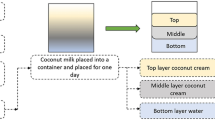Abstract
The solid waste generated in industrial berry juice production was considered as a low cost raw material for the extraction of natural antioxidants. Berries contain phenolic compounds with high antioxidant potential, including anthocyanins, proanthocyanidins, flavonols, catechins, benzoic and cinnamic acids. The solid residues generated from blueberry, cranberry and raspberry after pressing were extracted by conventional solvent extraction or by supercritical CO2 (SC–CO2) extraction. The effect of particle size and extraction time on the extraction yield, phenolic yield and phenolic content of the extracts produced by conventional solvents was assessed. Supercritical CO2 extraction was performed during 2 h operating in the range 80–300 bar at 60 °C using 2.5 L CO2/h. Maximum solubles yield of 5.20% were extracted from raspberry wastes at 200 bar, 3.89% from cranberry wastes at 250 bar and 1.4% from blueberry wastes at 200 bar. The highest phenolic content of the extracts was observed for blueberry pomace in the trap, with 9 grams of gallic acid equivalents per 100 g of extract. The ABTS (2, 2′-azino-bis-[3-ethylbenzotiazol-6-sulfonic acid]) and DPPH (α,α-diphenyl-β-picrylhydrazyl) radical scavenging capacity of the SC–CO2 extracts was moderate in comparison with the activity of conventional solvent extracts.





Similar content being viewed by others
References
Baysal T, Ersus S, Starmans DAJ (2000) Supercritical CO2 extraction of β-carotene and lycopene from tomato paste waste. J Agric Food Chem 48:5507
Barjaktarović B, Sovilj M, Knez Ž (2005) Chemical composition of Junuperus communis L. fruits supercritical CO2 extracts: dependence on pressure and extraction time. J Agric Food Chem 53:2630
Carvalho RN Jr, Moura LS, Rosa PTV, Meireles MAA (2005) Supercritical fluid extraction from rosemary (Rosmarinus officinalis): kinetic data, extract’s global yield, composition, and antioxidant activity. J Supercrit Fluids 35:197
Castro-Vargas HI, Rodríguez-Varela LI, Ferreira SRS, Parada-Alfonso F (2010) Extraction of phenolic fraction from guava seeds (Psidium guajava L.) using supercritical carbon dioxide and co-solvents. J Supercrit Fluids 51:319
Cheah ELC, Heng PWS, Chan LW (2010) Optimization of supercritical fluid extraction and pressurized liquid extraction of active principles from Magnolia officinalis using the Taguchi design. Sep Pur Technol 71:293
Conde E, Moure A, Domínguez H, Parajó JC (2010) The production of antioxidants by the NON-isothermal autohydrolysis of various lignocellulosic wastes. LWT-Food Sci Technol (In press)
Ehala S, Vaher M, Kaljurand M (2005) Characterization of phenolic profiles of Northern European berries by capillary electrophoresis and determination of their antioxidant activity. J Agric Food Chem 53:6484
Hasbay Adil İ, Çetin Hİ, Yener ME, Bayındırlı A (2007) Subcritical (carbon dioxide + ethanol) extraction of polyphenols from apple and peach pomaces, and determination of the antioxidant activities of the extracts. J Supercrit Fluids 43:55
He XJ, Liu RH (2006) Cranberry phytochemicals: isolation, structure elucidation, and their antiproliferative and antioxidant activities. J Agric Food Chem 54:7069
Ibáñez E, Oca A, de Murga G, López-Sebastian S, Tabera J, Reglero G (1999) Supercritical fluid extraction and fractionation of different preprocessed rosemary plants. J Agric Food Chem 47:1400
Kähkönen MP, Hopia AI, Heinonen M (2001) Berry phenolics and their antioxidant activity. J Agric Food Chem 49:4076–4082
Leahy M, Speroni J, Starr M (2002) Latest developments in cranberry health research. Pharma Biol 40:50
Määttä-Riihinen KR, Kähkönen MP, Törrönen AR, Heinonen IH (2005) Catechins and procyanidins in berries of vaccinium species and their antioxidant activity. J Agric Food Chem 53:8485
Mantell C, Rodríguez M, Martínez de la Ossa E (2003) A screening analysis of the high-pressure extraction of anthocyanins from red grape pomace with carbón dioxide and co-solvent. Chem Eng Technol 26:38
Moyler DA, Heath HB (1988) Liquid carbon dioxide extraction of essential oils. Dev Food Sci 18:41
Othmer D, Jaatinen W (1959) Extraction of soybeans. Mechanism with various solvents. Ind Eng Chem 51:543–546
Prior RL (2003) Absorption and metabolism of anthocyanins: potential health effects. Phytochemicals: mechanisms of action. CRC Press, Inc, Boca Raton
Reverchon E, Senatore F (1992) Isolation of rosemary oil: comparison between hydrodistillation and supercritical CO2 extraction. Flavour Frag J 7:227
Singleton VL, Rossi JA (1965) Colorimetry of total phenolics with phosphomolybdic-phosphotungstic acid reagents. Am J Enol Vitic 16:144
Taruscio TG, Barney DL, Exon J (2004) Content and profile of flavanoid and phenolic acid compounds in conjunction with the antioxidant capacity for a variety of northwest vaccinium verries. J Agric Food Chem 52:3169
Vatai T, Škerget M, Knez Z (2009) Extraction of phenolic compounds from elder berry and different grape marc varieties using organic solvents and/or supercritical carbon dioxide. J Food Eng 90:246
Yan X, Murphy BT, Hammond GB, Vinson JA, Neto CC (2002) Antioxidant activities and antitumor screening of extracts from cranberry fruit (Vaccinium macrocarpon). J Agric Food Chem 50:5844
Zafra-Stone S, Yasmin T, Bagchi M, Chatterjee A, Vinson JA, Bagchi D (2007) Berry anthocyanins as novel antioxidants in human health and disease prevention. Mol Nutr Food Res 51:675
Zhou S-H, Fang Z-X, Lu Y, Chen J-C, Liu D-H, Ye X-Q (2009) Phenolics and antioxidant properties of bayberry (Myrica rubra Sieb. et Zucc.) pomace. Food Chem 112:394
Acknowledgments
The authors are grateful to MCYT-FEDER (Research Project AGL2003-03596), Xunta Galicia (Research Project PGIDT, 04PXI38301PN) and CONICYT (Research Proyects FONDECYT N 1070258 and FONDEF D07I1045) for the financial support of this work. A. M. thanks the Isidro Parga Pondal Program of Xunta Galicia, B. D. R thanks the Spanish MEC (Grant BES-2005-7525) and L. L. is grateful to the MECE Program (Chile).
Author information
Authors and Affiliations
Corresponding author
Rights and permissions
About this article
Cite this article
Laroze, L.E., Díaz-Reinoso, B., Moure, A. et al. Extraction of antioxidants from several berries pressing wastes using conventional and supercritical solvents. Eur Food Res Technol 231, 669–677 (2010). https://doi.org/10.1007/s00217-010-1320-9
Received:
Revised:
Accepted:
Published:
Issue Date:
DOI: https://doi.org/10.1007/s00217-010-1320-9




